
FS-1141 | August 2020
What is Chilling Injury in Peaches, What Causes it, and How Can You Manage it?
Consumers expect peaches to be one of the most palatable fruits, possessing delicious, juicy, flavorful flesh with that glowing reddish-yellow skin that makes a healthy peach easily recognizable. However, the internal quality and flavor of wholesale peaches have not matched their perfect appearance. Physiological disorders, such as chilling injury, are one of the main causes of poor peach internal quality (Figure 1).

This lack of internal quality and flavor has directly affected the profitability of the wholesale peach industry in the mid-Atlantic region and nationally. The result has been a constant decline in peach production over the past 18 years. The loss of production is tightly linked to decreased consumption (Figure 2), which is fueled by consumers’ disappointment in the quality of peaches sold through the wholesale system.
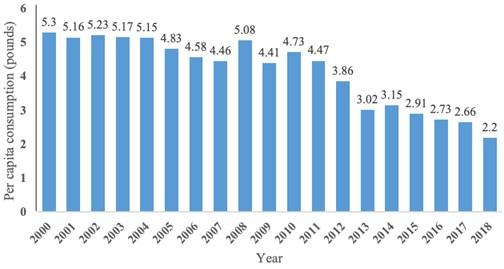
Peaches have a short shelf life capacity, thus are susceptible to extreme spoilage. Therefore, peaches destined for the wholesale market need to be harvested at early stages of ripening (i.e. mature (firmness of 10-12 lbs.) but not yet fully ripe (firmness of 2-4 lbs. and strong “peachy” aroma) and held at low temperatures during storage and transport to delay the ripening process. Chilling injury (CI) is a physiological disorder triggered by exposure to cold storage temperatures for a certain amount of time, especially when kept in the temperature range of 36-46°F (2-8°C). CI will only be perceived when the fruit are re-exposed to room temperature--when the fruit reaches consumers.
CI is an enormous challenge and leads to consumer disappointment through undesirable fruit internal quality. CI is manifested in many different symptoms including loss of flavor, mealiness, flesh browning, leatheriness, and flesh bleeding. Key factors that influence the susceptibility/ tolerance to CI include genetics, horticultural factors, harvest maturity, and postharvest storage practices. Management strategies available to decrease CI development include avoiding cultivars that are susceptible to CI, harvesting fruit at more advanced ripening stages, and avoiding storage at damaging temperatures, while promoting the use of preconditioning and intermittent warming.
High Perishability and Short Shelf Life of Peaches After Harvest Makes Them Susceptible to Rapid Spoilage
Peaches that are destined for the wholesale market are generally harvested at early stages of ripening, i.e. peaches are mature (firmness of 10-12 lbs.) but not yet fully ripe (firmness of 2-4 lbs. and strong “peachy” aroma), to allow proper handling. These fruits are placed in cold storage to delay the ripening process.
Though effective at extending overall shelf life, cold storage can induce development of CI and other physiological disorders. CI is triggered by exposure of peaches to cold temperatures for a certain period of time. To make matters worse, many of the symptoms of CI are not visible until the ripening process resumes (i.e., when the peaches are exposed to room temperatures in the grocery store). Thus, this problem is not perceived until the fruit reaches consumers, discouraging repeat purchases and directly affecting the profitability of the peach industry.
Generally, a longer duration of cold storage means more CI symptoms. CI is worse when peaches are kept in the temperature range of 36-46°F (2-8°C) and peaches are more susceptible to CI the earlier the stage of ripening at which they are harvested. Many other factors are at play, such as fruit genetic background, horticultural factors, fruit maturity at harvest, and postharvest management practices. CI is the main physiological disorder limiting shelf life as well as peach short- and long-term distribution.
What are the Symptoms of CI?
Flavor loss is the first CI symptom to develop. The flavor of peaches results from the interaction of sugars, acids and fruit aroma (made up of hundreds of volatile compounds produced by the fruit). Essentially, taste plus aroma volatiles make up flavor. However, the concentration of these compounds and their quality are heavily influenced by pre-and postharvest practices as well as environmental conditions. CI disrupts the balance of taste and aroma volatiles which in turn, affects fruit flavor and consumers’ eating experiences. (For more University of Maryland information, see How do Fruits Get Their Flavor? at: https://extension.umd.edu/sites/extension.umd.edu/files/2022-10/2020VegFruitNewsAlert-5-May18_0.pdf). Flavor loss is a particularly insidious CI symptom, because affected fruit may appear uninjured, but they never develop the flavor that consumers expect.
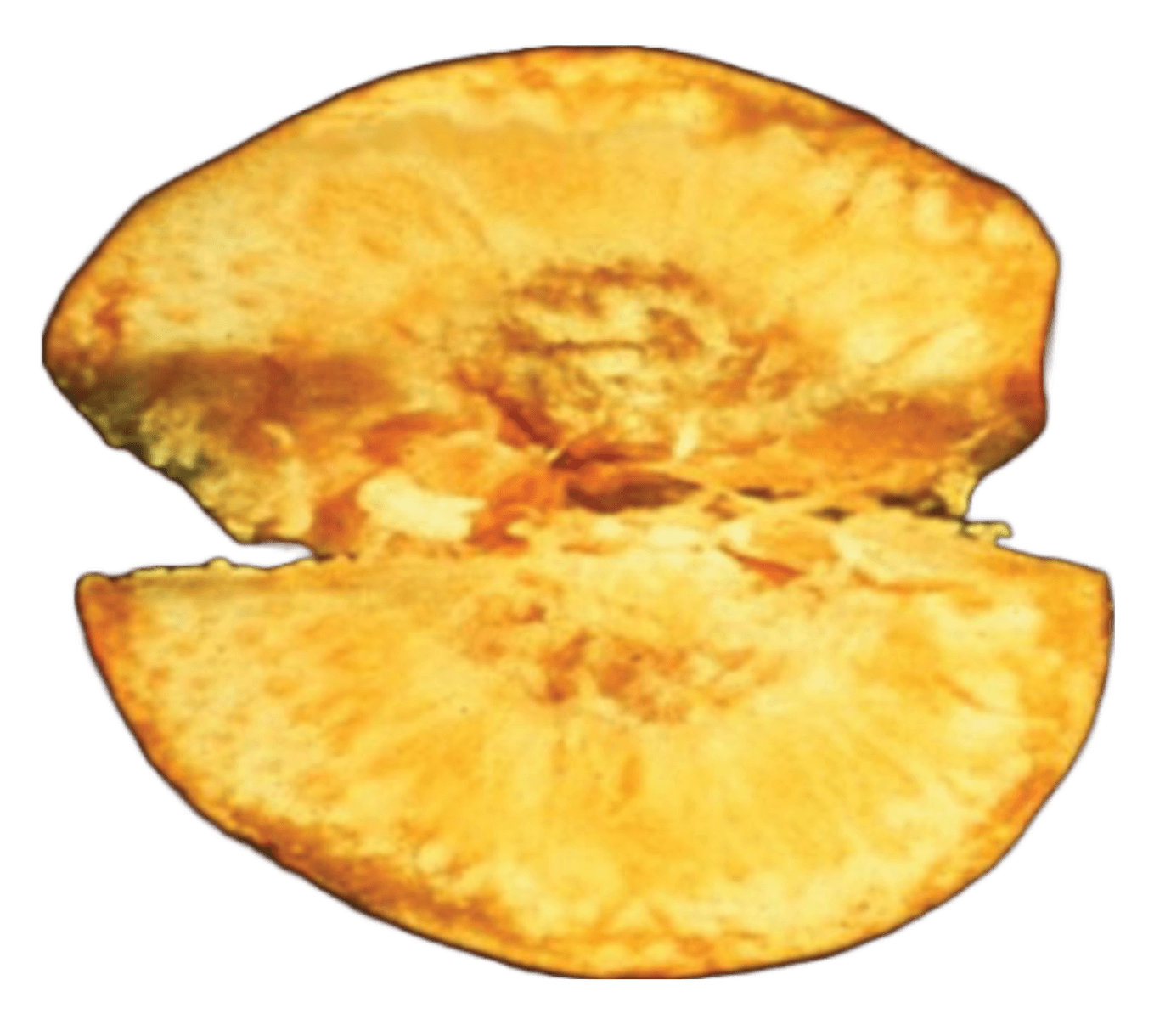
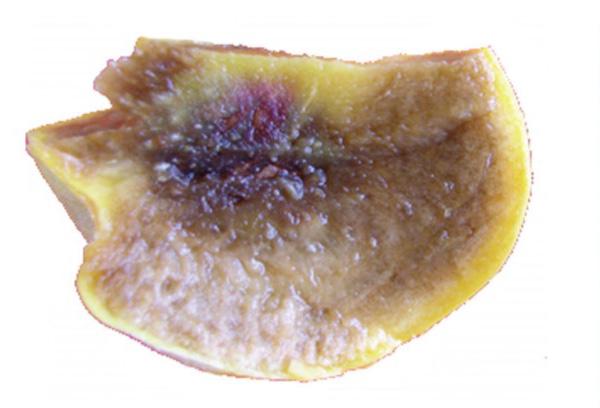
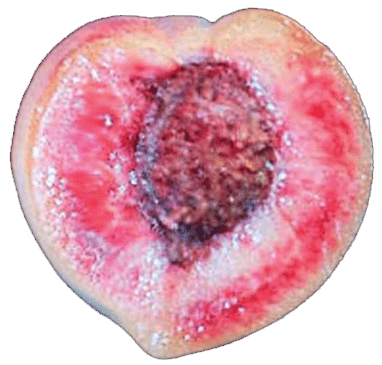
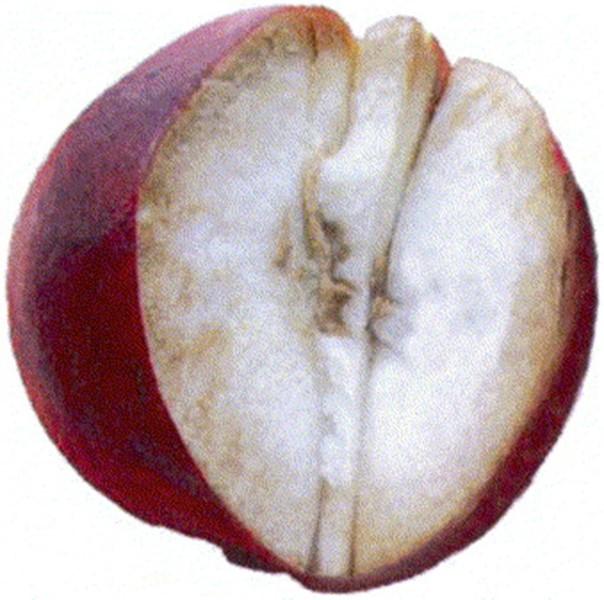
Mealiness is a lack of juice in the fruit flesh. Plant cell walls contain pectin which helps glue the cells together. When the fruit ripens normally, enzymes called pectinases help to degrade these pectins, thus softening the fruit flesh and releasing juices. When the pectinase enzymes are altered, the result is mealy fruit and incomplete or unbalanced pectin degradation. This causes a gel-like texture to form that traps water and sugars, resulting in dry mealy fruit texture (Figure 3). Mealiness usually becomes apparent during the later stages of ripening of the fruit and it can be a precursor to flesh browning.
Flesh browning is the discoloration of the fruit flesh, causing the lighter yellow and white colors of the flesh to turn brown (Figure 4). This is typically the next CI symptom following mealiness. This process is caused by the polyphenol oxidase (PPO) enzyme. PPO will oxidize many health-related compounds (phenolics), triggering the generation of dark brown pigments that contribute to overall browning of the peach flesh.
Flesh bleeding or internal reddening is the concentrated accumulation of red pigments, specifically around the fruit’s pit. During cold storage, these water-soluble red pigments, called anthocyanins, migrate through the flesh to congregate around the stone (Figure 5). “Flesh bleeding” has been used as a name for this CI symptom because the red pigment often appears to be “bleeding” from the pit. Bleeding does not affect the taste or texture of peaches but it can cause rejection of the fruit on the basis of its coloration, especially for canning/processing peaches.
Leatheriness refers to increased flesh pulp firmness, excessive loss of fresh weight, and the inability to ripen. Leathery patches in peaches are dry and firm when the fruit is ripe or remain firm as the fruit fails to ripen (Figure 6).
What are the Factors Involved in CI Development?
Since all the visible CI symptoms occur in the internal flesh of the fruit, it is very challenging to identify CI in peaches before the fruit reaches consumers. Therefore, it is critical to understand the factors involved in the development of CI to prevent its occurrence.
Peach genetic make-up (including freestone and clingstone types), differences in flesh texture (melting flesh versus non-melting flesh types), and flesh color each play a role in the development of CI. When selecting which cultivar to establish in your orchard, you should consider the peach characteristics in the context of the objectives of your operation.
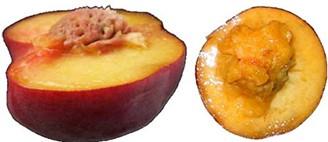
Freestone peaches are so named for the stone “freely” separating from the flesh, making it the most common peach for fresh consumption (Figure 7). In contrast, the flesh of clingstone peaches adheres to the stone of the peach, making it more desirable for processing/canning (melting flesh peaches disintegrate during processing, while clingstones don’t). Freestone cultivars are more prone to developing CI than clingstone cultivars.

Peach flesh texture is an important factor in consumer preference, whether it is a soft and juicy, melting sensation or a firm, non-melting texture (Figure 8). Most melting peaches are freestone, while most non-melting peaches are clingstone. Peaches with melting flesh practically fall apart and “melt” in the mouth when ripe, but this desirable quality has the drawback of higher vulnerability to CI. The soft flesh can be easily damaged in postharvest storage and spoils rapidly. In order to extend their shelf life, the melting flesh types must be picked mature or before fully ripe (firmness of 10-12 lbs.), which directly increases the risk of CI.
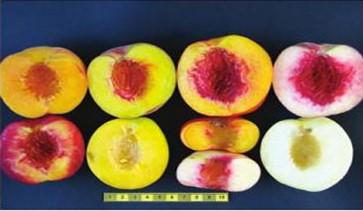
Flesh coloration differences can be expressed as white, yellow, and reddish pigments (Figure 9). In the United States, yellow-fleshed peaches are the most popular choice with their distinctive acidic and sweet taste. White peaches, which are less acidic, are popular with the Asian population. Peaches are still susceptible to developing CI, regardless of their flesh color. The late season (i.e. harvested August onwards) yellow flesh types develop CI more readily than earlier cultivars (i.e. harvested May-June), while white-fleshed peaches have much higher incidences of bleeding and browning symptoms.
Horticultural Factors Also Affect CI Development
Crop load and fruit size:
Lower crop loads increase peach size but also will increase susceptibility to mealiness and browning symptoms, with a shorter marketable life after cold storage. A balance between crop load and fruit size is recommended to avoid CI development in storage. For example, for small-, medium- and large-size cultivars, a reasonable target crop load is 45,000 fruit/acre, 70,000 fruit/acre and 100,000 fruit/acre, respectively.
Canopy position and light exposure:
Position of peaches on the tree canopy is also a factor in CI development, as different parts of the tree get varying sunlight exposure. The peaches harvested from the inner, shaded areas of the canopy have higher incidence of CI than the outer-growing ones. Light exposure is critical in producing fruit that will be less disposed to develop CI. Practices such as early summer pruning, leaf removal around the fruit or use of reflective mulches can help improve light distribution in the canopy and therefore, decrease susceptibility to CI.
Fertilization and irrigation practices:
Ensure balanced mineral nutrition (avoid excessive nitrogen applications) and avoid erratic irrigation practices (such as deficit irrigation, where drought stress is applied to the tree) to reduce the susceptibility to CI in storage.
Fruit maturity at harvest:
One of the main challenges for peach production and distribution is maturity at harvest which will affect overall fruit quality, flavor and marketability. Peaches for wholesale distribution are typically harvested when they are mature (firmness of 10-12 lbs.) but not yet fully ripe (firmness of 2-4 lbs. and strong “peachy” aroma) to ensure that the fruit can be transported easily without being damaged. Peaches harvested at this earlier stage are more susceptible to CI. On the other hand, fully ripe peaches present the lowest susceptibility to CI, but have a limited handling and storage capacity. Newer fresh-market peach cultivars have non-melting or other high flesh firmness traits so that they can be harvested at riper stages than melting types and still be successfully marketed. Thus, choice of cultivar and harvesting at the correct time based on the objective of your operation are crucial.
Postharvest Factors and CI Development
- Storage temperature and length of storage are the key factors influencing the development of CI. In peaches, CI will develop when cold storage temperatures reach the temperature range of 36-46°F (2-8°C). This temperature range is low enough to induce CI while at the same time is high enough to allow CI symptoms to develop in storage. The longer peaches are stored at these temperatures, the higher the susceptibility to develop CI. The ideal storage temperature for peaches is 32°F (0°C), because this low temperature inhibits CI symptom development during storage.
- Relative humidity levels in cold storage should be maintained around 90%-95% to avoid moisture loss which can potentially induce CI.
- Manipulation (bruising) that results in damage to the skin and flesh of the peach will greatly contribute to CI development (Figure 10). Exposing the flesh to the air and rapidly accelerating the activity of browning enzymes such as PPO induces the development of internal browning symptoms.

What are Some of the Management Strategies Used to Minimize Development of CI in Peaches?
There are several preharvest and postharvest strategies that can help reduce the susceptibility to CI, including:
- Preharvest application of Gibberellic acid (GA3), a plant hormone that promotes fruit growth and is also involved in processes such as flowering, seed germination, dormancy and senescence. In white, melting flesh peaches, applying gibberellic acid (ProGibb®) at the pit hardening stage of development (around 45 days after anthesis) has reduced CI during storage.
- Postharvest preconditioning by holding peach fruit at 68°F (20°C) for 24-48 hours after packing but prior to cold storage (32°F; 0°C). Fruits stored under these conditions have been shown to develop considerably less CI by stimulating metabolic processes related to ripening that help decrease CI development. The practice of preconditioning allows peaches to be harvested firm enough to withstand the physical stresses of packing, then ripen enough to reduce CI susceptibility. It is important to consider that weight loss and fruit softening must be constantly monitored when preconditioning peach fruit.
- Postharvest intermittent warming occurs when peaches are immediately stored at (32°F; 0°C) after harvest but removed every 10 to 14 days and exposed to 68°F (20°C) for one day before being returned to cold storage. This method stimulates healthy ripening for the remainder of cold storage. It is important to consider that weight loss and fruit softening must be constantly monitored through intermittent warming of peach fruit. Also, there is an energy cost associated with re-cooling the fruit after warming.
- Postharvest ethylene treatments, where ethylene is a gaseous plant hormone that promotes fruit ripening. The fruit itself can produce ethylene. Thus, ethylene treatment is similar to preconditioning. Fruit with greater capacity to produce ethylene during cold storage have been shown to develop less severe CI symptoms.
References
- Baugher, T., R. Marini. 2016. The Peach Pruning Blueprint. Penn State Extension. Retrieved from https://extension.psu.edu/the-peach-pruning-blueprint
- Byrne. D. and Anderson, N. 2014. Zest Peaches Series, Medium-chill Yellow-fleshed Cultivars. HortScience 49(4): 506-508. https://doi.org/10.21273/HORTSCI.49.4.506
- Crisosto, C.H., E.J. Mitcham, and A.A. Kader. 1996. Fresh Produce Facts. http://postharvest.ucdavis.edu/Commodity_Resources/Fact_Sheets/Datastores/Fruit_English/?uid=39&ds=798 Accessed April 15, 2020.
- Ju, Zh., Y. Duan, and Z. Ju. 2015. Leatheriness and mealiness of peaches in relation to fruit maturity and storage temperature. The Journal of Horticultural Science and Biotechnology 75 (1): 86-91. https://doi.org/10.1080/14620316.2000.11511205
- Layne, D. and D. Bassi. 2008. The Peach: Botany, Production and Uses. CAB International.
- Lurie, S., and C.H. Crisosto. 2005. Chilling Injury in Peach and Nectarine. Postharvest Biology and Technology 37(3): 195-208. https://doi.org/10.1016/j.postharvbio.2005.04.012
- Manganaris, G.A., A.R. Vicente, P.J. Martínez-García, and C.H. Crisosto. 2019. Peach and Nectarine Chapter 13: Pages 253-259. In Postharvest Physiological Disorders in Fruits and Vegetables. Boca Raton: CRC Press, https://doi.org/10.1201/b22001
- Manganaris, G.A., M. Vasilakakis, Gr. Diamantidis and I. Mignani. 2006.Cell wall physicochemical aspects of peach fruit related to internal breakdown symptoms. Postharvest Biology and Technology 39: 69–74. https://doi.org/10.1016/j.postharvbio.2005.08.003
- McCaughey, E. and M. Farcuh. 2020. How do Fruit Get Their Flavor? University of Maryland Extension Vegetable and Fruit News Special Alert #5. May 2020: 8-12. https://extension.umd.edu/sites/extension.umd.edu/files/2022-10/2020VegFruitNewsAlert-5-May18_0.pdf
- Pegoraro, C., M.R. Zanuzo, F.C. Chaves, A. Brackmann, C.L. Girardi, L. Lucchetta, L. Nora, J.A. Silva, and C.V. Rombaldi. 2010. Physiological and molecular changes associated with prevention of woolliness in peaches following pre-harvest application of gibberellic acid. Postharvest Biology and Technology 57: 19–26. https://doi.org/10.1016/j.postharvbio.2010.02.003
- Pliakoni, E.D. and Nanos, G.D. 2010. Deficit irrigation and reflective mulch effects on peach and nectarine fruit quality and storage ability. Acta Hortic. 877, 215-222 https://doi.org/10.17660/ActaHortic.2010.877.22
- Zhou, H.-W., S. Lurie, R. Ben-Arie, L. Dong, S. Burd, A. Weksler. 2001. Intermittent warming of peaches reduces chilling injury by enhancing ethylene production and enzymes mediated by ethylene. Journal of Horticultural Science and Biotechnology 76 (5): 620-628. https://www.researchgate.net/publication/288172806_Intermittent_warming_of_peaches_reduces_chilling_injury_by_enhancing_ethylene_production_and_enzymes_mediated_by_ethylene
KEVIN MOORE
kmoore20@umd.edu
MACARENA FARCUH
mfarch@umd.edu
This publication, What is Chilling Injury in Peaches, What Causes it, and How Can You Manage it? (FS-1141) is a part of a collection produced by the University of Maryland Extension within the College of Agriculture and Natural Resources.
The information presented has met UME peer-review standards, including internal and external technical review. For help accessing this or any UME publication contact: itaccessibility@umd.edu
For more information on this and other topics, visit the University of Maryland Extension website at extension.umd.edu
University programs, activities, and facilities are available to all without regard to race, color, sex, gender identity or expression, sexual orientation, marital status, age, national origin, political affiliation, physical or mental disability, religion, protected veteran status, genetic information, personal appearance, or any other legally protected class.